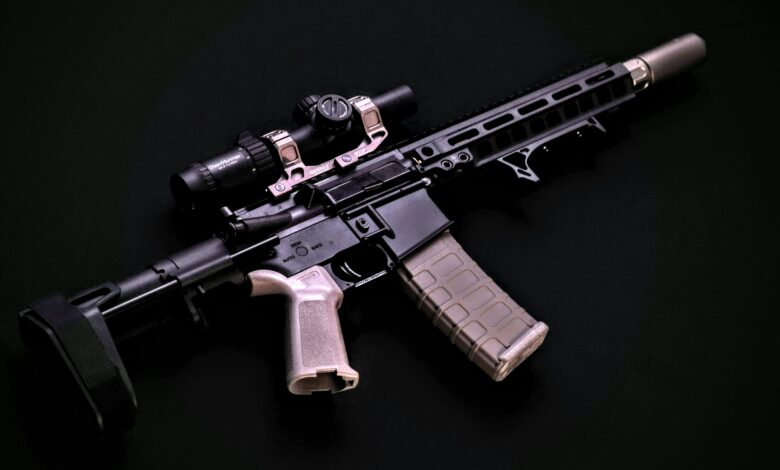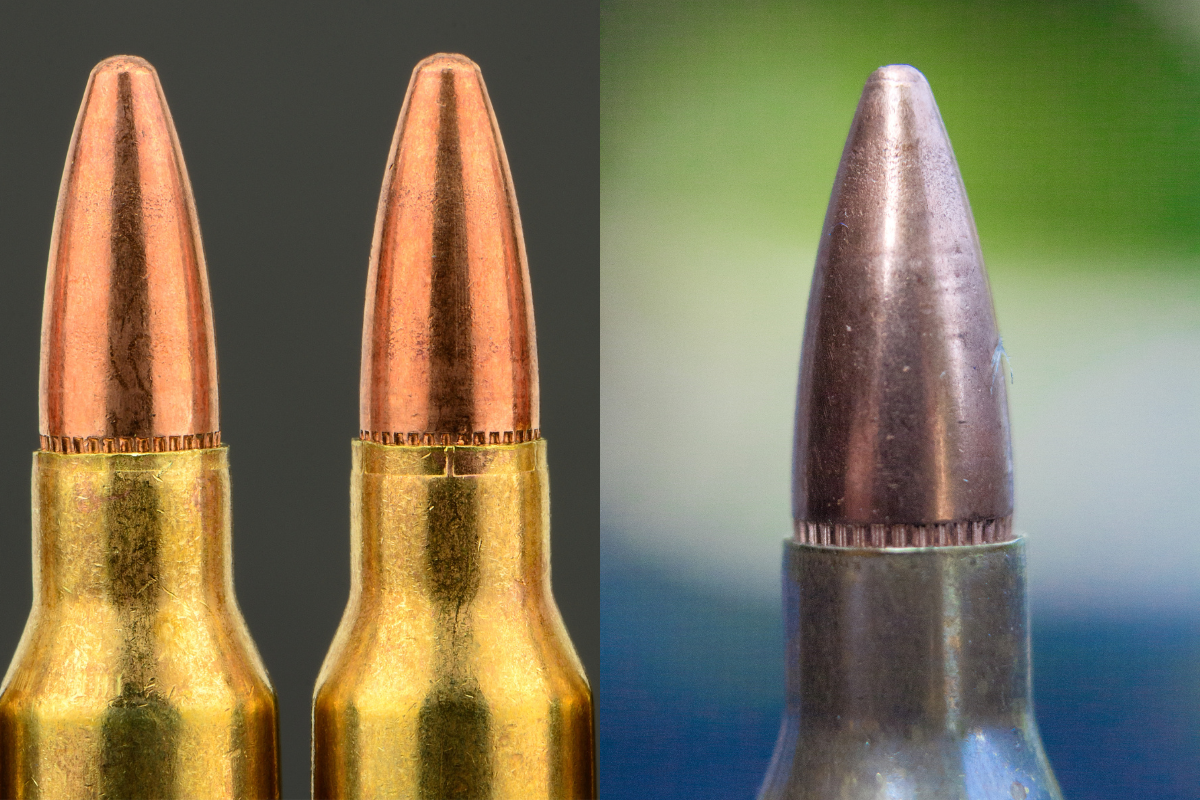.223 vs 5.56: Complete Ammunition Comparison and Guide

Here is a question that has got firearm enthusiasts confused for decades. Is there a difference between the .223 Remington and 5.56 NATO ammunition?
Want the short answer?
Yep!
Even though they look similar, the two rounds are not the same.
Many young shooters may try shooting a 5.56 NATO out of a .223 chamber as the rounds are identical. But that is plain wrong. In reality, these two rounds are like close cousins with different personalities.
And you know what else?
Understanding the difference between the two is crucial as it can have a serious impact on the user in terms of gun safety.
So, in this .223 vs 556 discussion, we will address the following points.
- The history of the rounds
- Technical and performance differences
- Expert opinions
- Lots more…
Historical Background
The history of the 5.56 NATO is linked with that of the .222 Remington. No wonder that the two projectiles look identical.
Even though the .223 Remington was officially born as a commercial sporting cartridge in 1964, its history goes back to 1950. In that year, the Remington Arms Company introduced the .222 Remington for the Model 722 bolt-action rifle.
But, the Army wanted a .22-caliber cartridge that could fulfill two conditions. Firstly, the projectile should stay supersonic at 500 yards. Next, at that distance, it should penetrate at least one side of a U.S. Army steel helmet.
In 1957, the technical editor of Guns and Ammo magazine, Robert Hutton, increased the length of the 0.222 to 2.260 inches, to hold more power.
Eugene Stoner, who was working with Armalite to design the AR10 and AR15 rifles, started combining these bullets with his rifles. In 1962, the combination of the 5.56-mm cartridge and AR-15 rifles was field tested and generated “instantaneous one-shot kills”.
How the .223 Remington made its way through the upper echelons of the U.S. government is a fascinating story in itself. Suffice it to say that by 1963, the .223 Remington was adopted by the U.S. military. Combined with the ArmaLite’s M16 rifle, the military named the bullet as the 5.56×45. The .223 Reminton is the civilianized version of the military cartridge.
Fast forward to 1977, NATO was looking for a smaller substitute for the 7.62×51mm NATO cartridge. The 5.56×45mm was tested and accepted as a NATO standard. The main reason for that was simple. A warrior with a lighter cartridge can carry more firepower and kill more enemies.
How to Identify .223 vs 5.56 Ammunition
Since firing 5.56 NATO rounds in a .223 Remington chamber can be unsafe, it’s essential to know exactly what you’re loading. But with identical case dimensions, how can you tell them apart?
The easiest way is to check the original packaging. If you see “5.56mm,” “M193,” or “M855” on the box, you’re dealing with 5.56mm NATO ammunition. Any reference to “.223 Remington” means it’s the civilian variant.
If you don’t have the original packaging, examine the headstamp on the base of the cartridge around the primer. Military 5.56mm rounds typically have 2-3 letters, 2-3 numbers, and the NATO cross (a circle with a cross through the middle). This NATO cross is the definitive marking that identifies military 5.56 ammunition.
Military 5.56mm rounds also feature a primer pocket crimp — extra material added to secure the primer and prevent it from backing out during automatic fire. This crimp is visible as a slight ring around the primer.
In contrast, commercial .223 Remington ammunition often has straightforward headstamps like “.223 Rem” followed by the manufacturer’s name, such as “Hornady” or “Federal.”
These identification methods aren’t just academic — they’re safety measures that help ensure you’re using the right ammunition for your firearm. Taking a few seconds to verify what you’re loading could prevent damage to your rifle or potential injury.
Technical Differences
While the .223 and 5.56 look identical, the similarity is just skin deep. There are differences between the two rounds that create a lot of impact in terms of performance and weapon function.
Dimension
What makes things confusing with these two bullets is the similar dimensions. The .223 and the 5.56 have the same overall length of 2.26 inches. The diameter of both bullets is also the same at 0.224 inches and the shoulder-to-neck angle is 23 degrees.
Beyond that, the 5.56 military round has a slightly thicker brass case than the .223. But, you will need a micrometer to spot this difference. The thicker construction allows the 5.56 round to withstand heavier chamber pressures.
Note, that the result of a thicker shell is less internal volume. So, if you reload your ammunition, make sure to segregate the two ammunition types.
If you check the bottom of the 5.56 NATO round, you will find a cycle with a cross stamped on it. This indicates that the round has been manufactured as per the NATO specs.
Chamber Dimensions
The other difference is in the rifles and pistols using the 5.56 NATO round. Those weapons have a marginally longer throat or “Leade”. The leade is the dead space between the resting bullet and the point where the rifling grooves in the barrel start. With the 5.56 chamber, this is 0.125 inches longer or twice the leade dimension in a .223 chamber.
What makes this chamber dimension so special? Let us move to the next point to find out.
Pressure
As per the specifications of the Sporting Arms and Ammunition Manufacturers’ Institute (SAAMI), the chamber pressure of the .223 Remington is 55,000 psi. With the 5.56x45mm NATO round, it stands at 61,000 psi.
The pressure numbers from million-dollar labs can get confusing as different reliable sources offer different values. To make things even more confusing, some chamber pressure values are given in Copper Units of Pressure (CUP). Mathematical conversion of CUP values to psi is not possible.
Then again, there is the question of the point of pressure measurement. In the 5.56 military round, the pressure is measured at the tip of the case. For the .223 Remington, SAAMI measures the pressure at the case mid-point. This causes a variance in the results.
The point is that the 5.56 NATO operates at a higher pressure. A higher pressure translates into higher velocity and more damage to the target. This helps in meeting the army’s objective of penetrating steel helmets at 500 yards.
This is where the extra chamber space for the 5.56 round helps. This space neutralizes the higher chamber pressure, not allowing it to blow back into the casing.
Performance Differences
If you compare the .223 vs 5.56 from Winchester, the muzzle velocities are almost the same. But look closer and you will find that the velocity and energy carried by the 5.56 ammunition are marginally higher.
That said, things can get confusing with muzzle velocities. Winchester lists a higher muzzle velocity for their FMJ 55-grain 223 rounds than the 5.56 rounds. It is 3240 fps for the .223 round vs 3180 fps for the 5.56.
But this is not always the case. Sig Sauer mentions that both 77-grain .223 projectiles and 5.56 projectiles have a similar muzzle velocity of 2,750 fps.
Now, these numbers may not be accurate in real-life situations. I have noted an average muzzle velocity of 2950 fps for the Winchester 223 from an 18-inch barrel. Whereas for the 5.56, it is around 3030 fps.
Coming to trajectory, a 5.56 NATO round will drop around 1.07 inches at 300 yards. With a .223 Remington, the drop will be around 11.4 inches. This indicates that the 5.56 cartridge has a flatter trajectory than the .223. This makes it a better choice for long-distance shooting.
Let’s not forget that the energy carried by a bullet and its accuracy depends on the grain size you pick. With lighter bullets, you get more speed which gives you the ability to make long-distance shots. On the other hand, a heavier bullet has better penetration and is more effective against larger games.
One advantage of both cartridges is the low amount of recoil that they generate. If you want to stay on target and make quick follow-up shots, both the cartridges will work great. Plus, both have low signatures (noise and flash) as well. This makes them great for first-time hunters.
Generally, you do not need a suppressor while using these two ammunitions. But there are some great suppressors available for the 5.56 that you can check out.
Note that the energy delivered by both cartridges drops significantly beyond 300 yards. You will still be able to penetrate steel targets between 400 to 500 yards, but with less energy. At 600 yards a NATO 5.56 Open Tip Match projectile delivers only 415 ft/bs. of energy.
Both cartridges can deliver excellent accuracy. However, the .223 was developed for varmint hunting for which accuracy was all-important. With the higher velocity of the 5.56 ammo, some accuracy can be lost.
In my experience, the .223 Remington ammunition delivers better accuracy between 200 to 300 yards. I used a 1-in-8 barrel twist rate with 55-grain FMJ bullets and the accuracy was scary good. A 1 in-12 barrel twist rate should work well too with a 50-grain.
But a lot will depend on your rifle condition and ammunition selection. Also, your skill with the weapon makes a big difference.
Compatibility and Safety
If you are lost in the fog of numbers, allow me to make the question simple. Can your .223 rifle withstand the high pressure from a 5.56 round?
Before drawing conclusions, here is a look at what the SAAMI website mentions:
“However, it is not safe to shoot “5.56,” “5.56 NATO,” or “5.56x45mm” ammunition in a barrel marked as being chambered in 223 Remington for a number of reasons… This can result in serious injury or death to the user and/or bystanders, as well as damage to the firearm.”
In short, it is not a safe practice. Now, you may not notice any difference after firing one round. But, by firing rounds consistently, you are constantly subjecting the rifle to pressure spikes that can touch 70,000 psi.
We know that rifles get hot while shooting. Imagine shooting in the range on a hot summer day with the excessive pressure adding to the stress on the rifle. This can lead to the rifle jamming or various other problems. Worst case scenario, the gun can blow apart and damage your fingers and eyes.
The fact is that most modern rifles are designed with a factor of safety. So the chances of it exploding in your hand are pretty low. But if you ask me, it is not a risk worth taking.
Unless you want to take the rifle to a gunsmith to modify the bore, it is best to stick to the ammunition that your weapon was designed for.
Fair enough, but what about the reverse?
Well, you can safely shoot .223 bullets from a 556 rifle all day long. The extra space in the chamber will not cause any safety issues but the cartridge may not perform optimally.
If you are using the .223 with an AR pistol, the low chamber length and muzzle pressure can affect the gun’s cycling. Generally, with a barrel more than 14.5 inches long, this should not be a problem.
Now, there are hybrid rifle chambers like the .223 Wylde chamber that can safely fire both the 5.56 NATO and the .223 Remington ammunition. This is possible due to the longer throat length and the gentle lead angle that helps to release the higher pressures. The best part is, you have a wider range of choices with a gun that can shoot both types of ammo safely.
.223 vs 5.56 Reloading Procedures
If you’re reloading .223 and 5.56 brass, there are a few key differences to understand. Don’t worry about special 5.56 dies — they don’t exist. Standard .223 Remington dies work for both because the case dimensions are identical. I’ve had great results with Redding, Hornady, and Dillon dies.
The main challenge with 5.56 NATO brass is the primer pocket crimp. Military 5.56 cases have crimped primer pockets that must be removed before reloading. You’ve got three options for this:
A chamfer/deburring tool works but risks removing too much material, potentially causing loose primers. Case prep stations from Lyman and Hornady use rotating primer pocket swagers that remove crimps without excess material loss.
My favorite is the Dillon Primer Pocket Swager — it bolts to your bench and lets you remove crimps quickly with a lever motion.
Beyond these differences, you’ll find loads of bullet options from 45-grain varmint bullets to heavier 77-grain projectiles for long-range shooting with your AR-15, Mini-14, or Remington 700.
Remember — you can load both brass types to .223 specs, but only load to 5.56 pressures in brass that will be fired from 5.56 chambers. Always follow your reloading manual’s guidelines for safety.
Applications and Use Cases
Overall the performances of the two cartridges are similar when you use the same bullet weights and types. For hunting coyotes or deer, both the .223 Remington and 5.56 NATO are great options. Personally, I would choose the .223 for making shots within 300 yards.
If you are shooting from a ground blind and the wind is not strong, these cartridges will get the job done. Even so, both these are small cartridges and do not pack a lot of propellant. So, they can be easily deflected. Ideally, keep the range short and focus on accurate shot placement.
For making challenging shots at longer distances and in adverse conditions, I would prefer a more reliable cartridge. Something like a Remington 700 rifle with a .280 Remington caliber.
The cartridges also perform well for recreational shooting. In short, both cartridges are solid performers in most tasks, except the large ones.
In theory, the 5.56 NATO cartridge has a slightly better terminal performance. In other words, it transfers more energy to the target. So it is a better choice for law enforcement applications where a high stopping power is required.
Now, this can be controversial, but some reports suggest that the 5.56 is not the perfect “one-shot man-stopper”. You might have read the book Black Hawk Down which describes the actual performance of the ammunition in the infamous mission in Mogadishu, Somalia in 1993.
Then again, the 5.56 NATO was bred for use in war and is more versatile. So, if you are not sure of the type of shooting you will be doing, this is a better choice. Lastly, check the compatibility of the cartridge with your weapon before choosing.

Pros and Cons
Here is a quick look at the pros and cons of both the cartridges:
The .223 Remington
Pros
- Good for small to medium-sized game
- Cheaper than the 5.56 cartridge
- Low recoil
- Good for making accurate shots
Cons
- Not ideal for larger game
- Not the best for making tough shots.
The 5.56 NATO
Pros
- A flatter trajectory
- Non-existent recoil
- Good for hunting and self-defense
- High hit probability in combat
Cons
- Not for larger game
- Inconsistent wounding effect
Availability and Cost
Both the .223 and. 5.56 ammos are readily available on the market. That said, you might find more versions of the .223 Remington available in the store. But there are military stocks of the 5.56 cartridge available. In fact, you can even buy both types of cartridges in bulk and save more.
Generally, the 5.56 NATO will cost you more than the .223 Remington. However, the costs depend on the rounds’ overall quality and precision. If you are hunting for small game, the .223 is the more value-for-money option.
As a side note, the US Army’s shift to the Next Generation Squad Weapons System (NGSWS) in the coming years can impact the prices. This system will use the 6.8mm ammunition instead of the 5.56mm. This can cause a fluctuation in the price of the 5.56 NATO rounds starting from an initial decline in the prices.
Legal Considerations
Federal law permits the sale or possession of the .223 or 5.56 ammunition. Even so, it is best to check the local laws regarding age restrictions on the sale of ammunition, and online sales.
Expert Opinions
Many experts have praised the .223 Remington and 5.56 NATO bullets for their versatility. Retired Sgt./Maj. Kyle E. Lamb, who spent 15 years with Special Operations has enough combat experience to talk in-depth about the “AR-15 chambered in 5.56×45 mm NATO/.223 Rem.”
In a discussion with American Rifleman, he mentions that these rounds combined with an AR-15 carbine are easy to use and allow the shooter to remain in total control of the system. “Once again, focusing on reality, 5.56×45 mm NATO ammunition just plain works. There are literally thousands upon thousands of terrorists who have met their ends because of it,” he adds.
Now, you may say that neither cartridge will have the same effects as that of a large-caliber bullet on big-bodied bucks. And you are not wrong. However, according to the chief of the small arms division at Fort Benning, Maj. Thomas Henthorn, “If you hit a guy in the right spot, it doesn’t matter what you shoot him with.”
That does make a lot of sense even for hunters.
FAQs
What does 5.56 stand for?
The term “5.56” refers to the land diameter of the bullet which is 5.56 millimeters.
Is 5.56 ammo better than 223?
Both types of ammunition offer similar performance. But the 5.56 is better at long-range shooting than the .223 Remington.
Why can’t you shoot 5.56 out of a 223?
A rifle designed for a .223 bullet may not be able to handle the increased pressure of a 5.56 NATO round. This can make it unsafe for the shooter.
Are 5.56 and 5.56 NATO the same?
They are often used to imply the same bullet. Technically, 5.56 is a number that specifies a particular dimension of the ammunition. The 5.56 NATO is ammunition that has been built in line with the NATO specs.
Final Thoughts
So it all adds up to this…
Both .223 Rem and 5.56 NATO have the same dimensions and deliver similar performances. But, they differ in terms of the chamber pressure generated. Since the 5.56 round generates higher pressure, firing it from a commercial .223-chambered rifle is not a safe option.
In any case, putting one of these two cartridges above the other is not possible. Both are versatile performers, deliver excellent accuracy, and rank high in terms of ammunition sales.
While there can be minor differences in accuracy and performance, they should not matter for an average AR15 buyer.
In the end, it all depends on your preferences and shooting needs.



